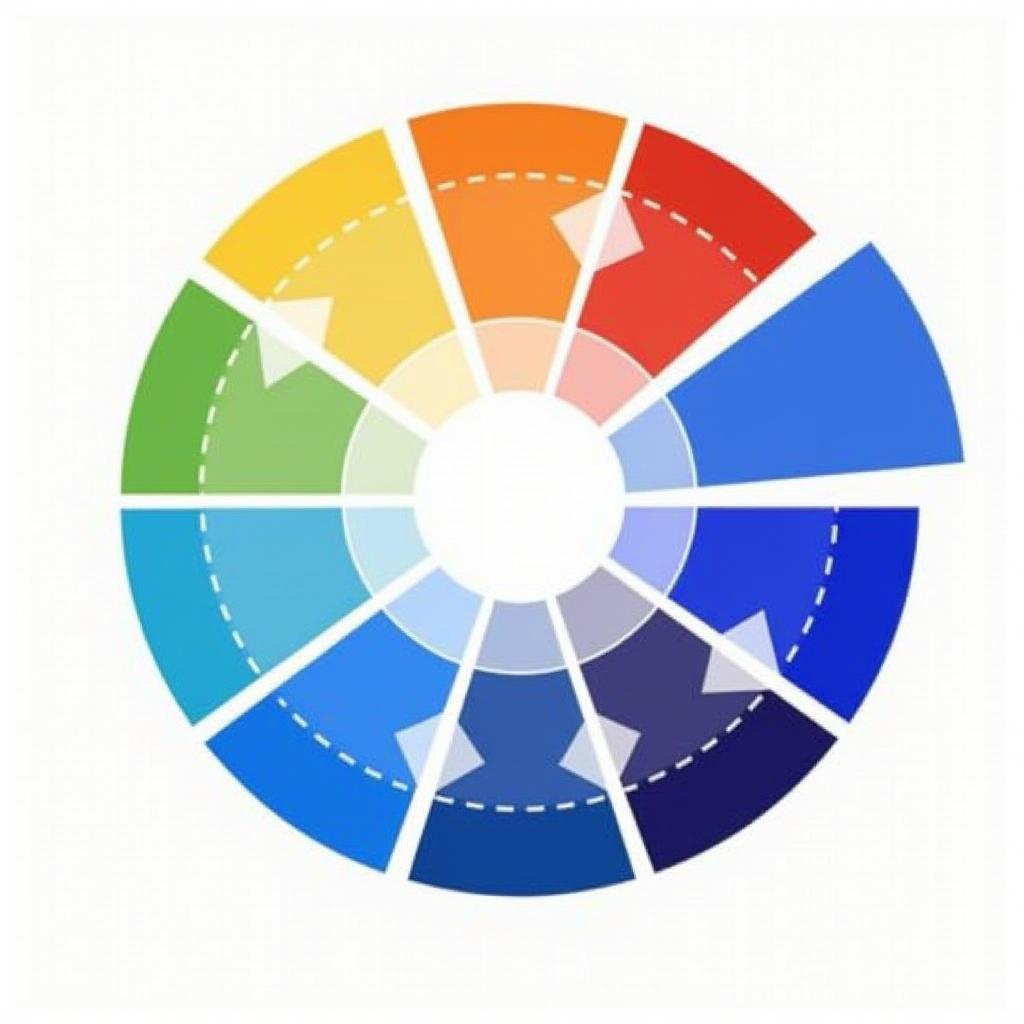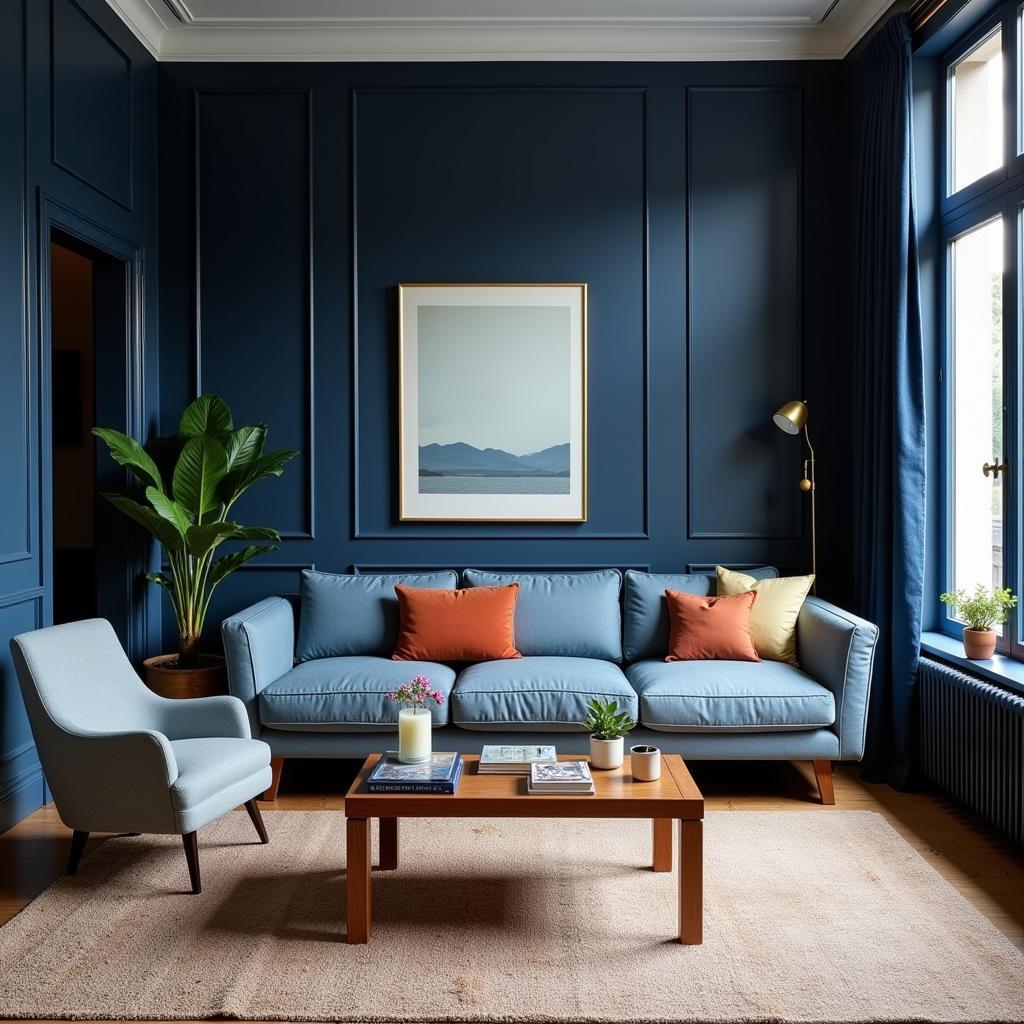Dark blue, a color often associated with depth, stability, and sophistication, is a popular choice for home decor, fashion, and art. But have you ever wondered what colors are used to create this rich and versatile hue? While it might seem counterintuitive, you don’t actually use darker colors to make a darker blue. It’s all about understanding the interplay of primary colors and their proportions.
Deconstructing Dark Blue: A Primary Color Perspective
Believe it or not, the journey to dark blue begins with a color that couldn’t be more different: blue itself! It all starts with a pure, vibrant blue. To achieve a darker shade, you don’t add black, as you might initially think. Instead, you introduce its complementary color on the color wheel: orange.
 Mixing Blue and Orange
Mixing Blue and Orange
The Role of Orange: Deepening the Hue
Adding orange to blue might seem like a recipe for disaster, but that’s where the magic happens. Orange, being opposite blue on the color wheel, acts as a natural darkening agent. The more orange you incorporate, the deeper and richer the blue becomes. However, it’s crucial to add orange gradually and in small amounts to avoid muddying the blue or creating an unwanted brown hue.
Beyond Blue and Orange: Expanding the Palette
While the blue-orange combination is fundamental to creating dark blue, other colors can be introduced to achieve specific nuances and undertones:
- Purple: Adding a touch of purple to the blue-orange mix can lend a hint of royalty and sophistication to the dark blue. Think of the deep, velvety blue often seen in luxurious fabrics and gemstones.
- Green: A small amount of green can create a more complex and muted dark blue, reminiscent of the ocean depths or a stormy sky. This combination works particularly well for creating a calming and serene atmosphere.
- Black: While not ideal, adding a tiny amount of black can further darken the blue. However, it’s crucial to use black sparingly, as it can dull the vibrancy of the blue if overused.
Dark Blue in Action: Design Inspiration
 Dark Blue Living Room
Dark Blue Living Room
Dark blue’s versatility makes it a fantastic choice for various design styles:
- Modern: The clean lines and minimalist aesthetic of modern design pair beautifully with the boldness of dark blue. Imagine a sleek, dark blue sofa as a statement piece against a backdrop of crisp white walls.
- Traditional: Dark blue can add a touch of timeless elegance to traditional interiors. Picture a library with dark blue walls lined with bookshelves, accented by rich wooden furniture and warm lighting.
- Coastal: Evoking the depths of the ocean, dark blue works harmoniously in coastal settings. Consider a beach house with white-washed walls and accents of dark blue in the furniture, textiles, and decorative elements.
Beyond Interior Design: Dark Blue’s Universal Appeal
Dark blue’s appeal extends far beyond the realm of interior design. It’s a popular choice for fashion, where it exudes confidence and sophistication. In art, dark blue can convey a sense of mystery, depth, and emotion. Whether you’re drawn to its calming effect, its air of mystery, or its timeless elegance, dark blue offers endless possibilities for creative expression.
Conclusion
Understanding how to create dark blue opens up a world of possibilities for artists, designers, and anyone who appreciates the power of color. By mastering the interplay of primary and complementary colors, you can achieve the perfect shade of dark blue to suit your creative vision. So, go ahead and explore the depths of this versatile hue—you might be surprised by the stunning results!
FAQs
1. Can I mix black and blue to get dark blue?
While you can technically mix black and blue to darken it, this method often results in a flat, lifeless blue. For a richer, more vibrant dark blue, using orange as the darkening agent is recommended.
2. What colors go well with dark blue in a room?
Dark blue pairs beautifully with a range of colors, including crisp white, warm beige, sunny yellow, and even other shades of blue. Experiment with different color combinations to create a mood that reflects your style.
3. Can I use dark blue in a small room?
While often associated with larger spaces, dark blue can work surprisingly well in smaller rooms. The key is to use it strategically. Consider painting just one accent wall dark blue or incorporating it through furniture and accessories.
4. Is dark blue a good choice for a bedroom?
Yes, dark blue can create a calming and restful atmosphere in a bedroom. However, it’s essential to balance the dark blue with lighter colors and plenty of natural light.
5. What are some popular shades of dark blue?
Some popular shades of dark blue include navy blue, indigo, Prussian blue, and midnight blue, each offering its unique character and depth.
Don’t Forget to Explore!
- Curious about mixing other colors? Discover how to make skin color with primary colors.
- Intrigued by the symbolism of blue? Uncover what does it mean to dream of the color blue.
- Wondering how to style your outfit? Find out what color of shoes to wear with a blue suit or what color pants to wear with a dark blue shirt.
Need help bringing your color visions to life? Contact Color Box Hanoi today!
Phone: 0373298888
Email: [email protected]
Address: 86 Cau Giay, Hanoi.
We have a 24/7 customer service team ready to assist you.

